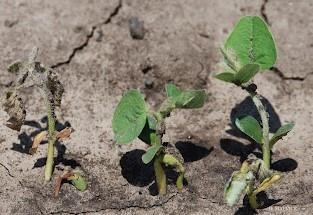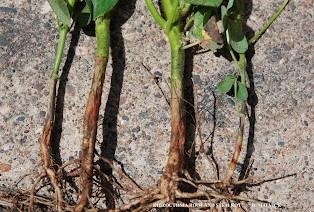By Dean Malvick
Conditions are favorable for soybean seedling disease in many areas. Wet soil, slow emergence, and delayed planting have been favorable for seedling diseases in many areas of southern and central Minnesota. Now as the soil dries and warms up, infected plants may wilt and collapse rapidly due to damaged root systems. Problems with seedling disease have been reported from several areas, and more will likely be noted as plants continue to emerge. Given that seedling diseases have developed in some of the well-drained soil at Rosemount, MN, these problems are not restricted to poorly-drained fields this year. This is a good time to scout fields for seedling disease problems.

How to know if seedling diseases are developing? Infection of seedlings before or after emergence can result in missing plants, plants that are stunted and dead, rotted roots, and wilting. Slow plant emergence could be due to many factors, including seedling disease and crusting. Vigilant scouting and diagnosis are often required to identify the main cause of a problem. Scouting can reveal where and which diseases are developing, and can assist in managing them and understanding efficacy of seed treatments for future years.
Scouting and Diagnosis: Timely scouting is important because seedling diseases often develop rapidly and seedlings can decompose quickly. Fresh, intact plants with clear symptoms and without extensive rotting are needed for diagnosis. Samples can be submitted to the University of Minnesota Plant Disease Clinic (pdc.umn.edu/) or other diagnostic laboratories for diagnosis.
Common Seedling Diseases. Pythium root rot, Rhizoctonia root and stem rot, Fusarium root rot, and Phytophthora root rot are common soybean seedling diseases in Minnesota. The soilborne pathogens that cause these diseases are widespread and persistent in field soils across the state. These pathogens are also key targets for most fungicidal seed treatments.
Pythium root rot. The wet and cool soils that occurred in many areas with the frequent rains in late May have been especially favorable for Pythium seed and seedling root rot. Pythium infections typically result in brownish-colored, rotting tissue. We have identified over 20 species of Pythium that infect soybean in Minnesota. Many of them can also infect corn seedlings, and some prefer warmer soil conditions than the others.
Phytophthora root rot is also favored by wet and saturated soils, although it generally prefers warmer soil conditions than Pythium root rot. The light, soft-rot symptoms on roots caused by Phytophthora are very similar to those caused by Pythium, and laboratory diagnosis may be required to tell which disease it is. Phytophthora can damage soybean seedlings or initiate infections in the spring that may result in severe root and stem rot in July and August. Two species of Phytophthora (P. sojae and P. sansomeana) are known to infect soybean in Minnesota.
Rhizoctonia root and stem rot caused by Rhizoctonia solani is also a widespread problem in Minnesota. Warm and moist soils favor Rhizoctonia root and stem rot. Plant stand loss can be high when soil is warm (>74F) and wet while seedlings are in the VE to V1 growth stages, as these are prime conditions for disease development. Thus late May to early June emergence in wet and warm soil favor Rhizoctonia root and stem rot. Reddish to dark brown, firm and often sunken, lesions caused by Rhizoctonia develop on the stem and often girdle stems near the soil line. The symptoms can be confused with those caused by other seedling diseases.

Fusarium root rot is another common soybean seedling disease in Minnesota that can cause significant damage. The typical symptoms are damping-off and root-rot with dark brown lesions. As with Pythium, there are multiple species of Fusarium (over 10) in Minnesota that can cause root rot on soybean (and corn). Many different conditions can favor disease development by the different species of the Fusarium pathogen.
Additional information on soybean seedling diseases can be found at the Minnesota Crop Diseases web site (www.extension.umn.edu/agriculture/crop-diseases/soybean/)